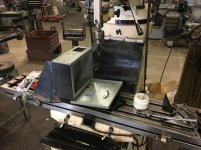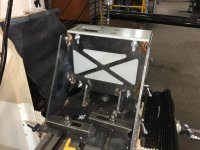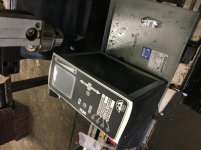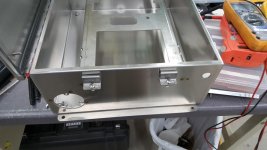El Mustachio
Hot Rolled
- Joined
- Jul 28, 2010
- Location
- Eastern Washington, USA
We build an operator control panel for our equipment that requires milling a pocket out of a sheet metal box for a joystick. The most trouble seems to come from trying to hold the workpiece as rigidly as possible. It's already formed into a box shape before it gets here.
When I first made these, I actually plasma cut the pockets. It worked, but it was messy, required some careful torch alignment, and just left a lot of mess to clean up before the wiring could be added.
Milling the slot seems to leave a better finish, less likely to snag the wiring, but only if I can keep the chatter down. The box has (4) holes in the bottom panel (perpendicular to the face I need to mill). I tried mounting it to a large channel (scrap truck frame) that was secured to the milling table. That worked for a few runs, but was still prone to vibration. This last time I made a fixture to hold it on 4 faces of the box, that's getting better. The channel mount held the box on one face. But even with the new fixture, I still fight vibration. If I run the spindle 200 rpm or less I can keep the vibration at a minimum.
My guess is that because of the preformed box shape, I'm probably going to never fully get rid of the vibration. I'm just looking for someone else to put eyes on this and see if I'm missing an obvious solution. Thanks in advance, pics below.




When I first made these, I actually plasma cut the pockets. It worked, but it was messy, required some careful torch alignment, and just left a lot of mess to clean up before the wiring could be added.
Milling the slot seems to leave a better finish, less likely to snag the wiring, but only if I can keep the chatter down. The box has (4) holes in the bottom panel (perpendicular to the face I need to mill). I tried mounting it to a large channel (scrap truck frame) that was secured to the milling table. That worked for a few runs, but was still prone to vibration. This last time I made a fixture to hold it on 4 faces of the box, that's getting better. The channel mount held the box on one face. But even with the new fixture, I still fight vibration. If I run the spindle 200 rpm or less I can keep the vibration at a minimum.
My guess is that because of the preformed box shape, I'm probably going to never fully get rid of the vibration. I'm just looking for someone else to put eyes on this and see if I'm missing an obvious solution. Thanks in advance, pics below.










